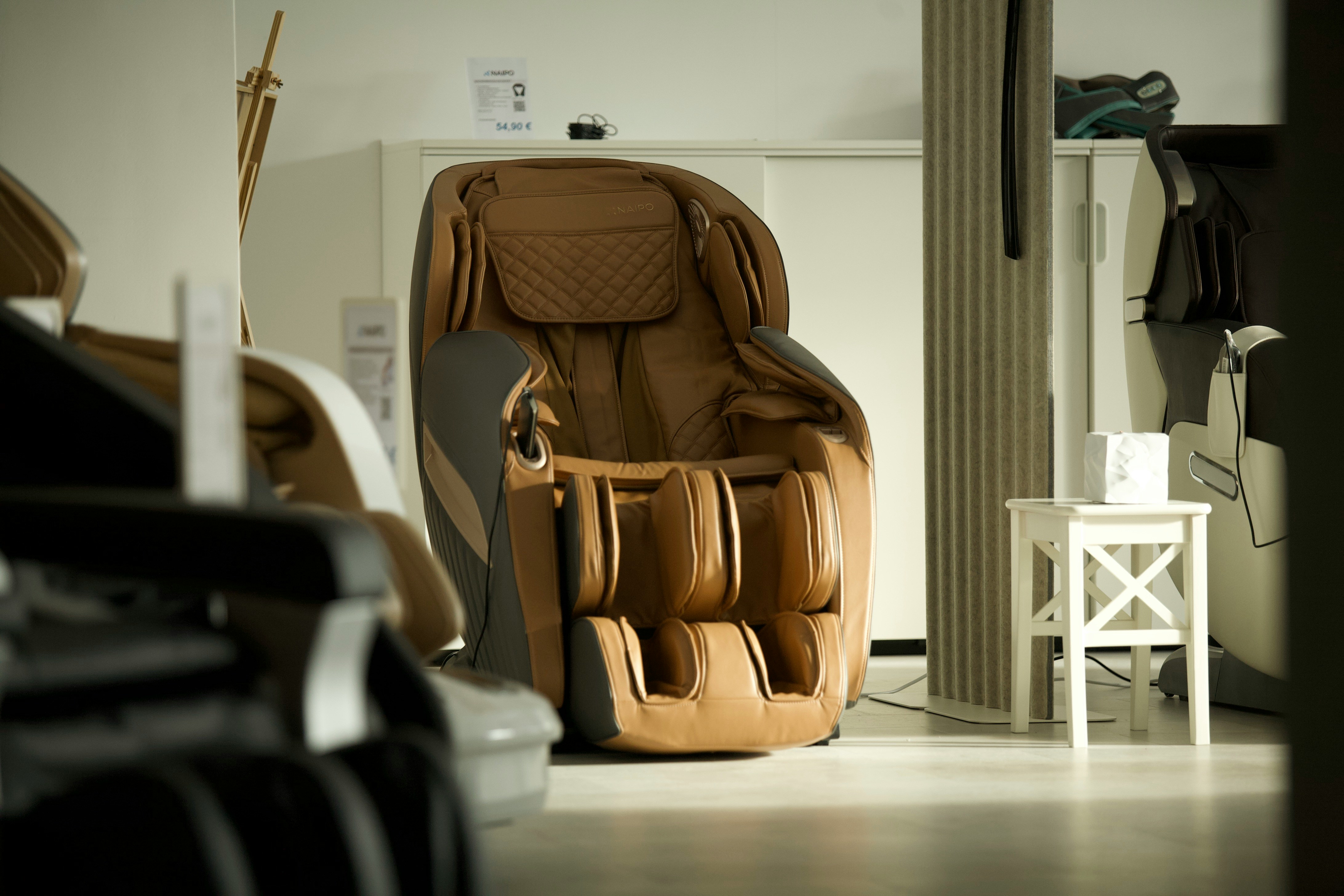Massage Chair
A massage chair is more than a seat – it's a gateway to holistic health and a daily escape from modern stressors. Designed to emulate the skilled hands of a licensed massage therapist, these innovative devices fall into two categories: traditional massage chairs, crafted for professional clinical use in spas and workplaces, and robotic massage recliners, powered by AI-driven mechanics and medical-grade engineering. Whether placed in a home gym, corporate office, or physical therapy clinic, they share a unified mission: to combat chronic back pain, improve spinal alignment, and stimulate blood circulation through techniques ranging from shiatsu acupressure to deep tissue percussion.
Over decades, massage chairs have evolved from basic vibrating seats to smart wellness ecosystems. Modern models integrate posture-correcting sensors that rival chiropractic adjustments, while zero-gravity positioning mimics therapeutic floating therapy used in rehabilitation centers. For remote workers battling tech neck or athletes recovering from muscle strain, these chairs offer targeted lumbar support and kneading foot rollers comparable to orthopedic devices.

The rise of home wellness technology has cemented their role as essential self-care investments – as commonplace as yoga mats for flexibility or air purifiers for respiratory health. Studies from the Journal of Pain Research highlight their efficacy in reducing migraine frequency by 38% and enhancing sleep quality through parasympathetic nervous system activation. With voice-controlled customization and biometric feedback systems, today’s models don’t just relax – they educate users about muscle tension patterns and postural imbalances, functioning like personal physiotherapists for preventive healthcare.
History of Massage Chairs: A Post-War Revolution in Relaxation
The genesis of massage chairs is deeply rooted in Japan's post-WWII economic miracle—a period when innovation collided with scarcity. In 1954, amidst reconstruction efforts led by the Ministry of International Trade and Industry, engineer Nobuo Fujimoto repurposed aircraft aluminum scraps and surplus jeep springs to craft his first prototype. This mirrored the nation's philosophy of mottainai (anti-waste)—a concept later applied to everything from energy-efficient appliances to compact car design.
Fujimoto’s creation emerged alongside iconic symbols of Japanese resilience: the Shinkansen bullet train (1964) and instant noodles (1958). Unlike Western ergonomic chairs focused on office productivity, his design prioritized acupressure point stimulation, drawing from kampo medicine traditions. By 1967, the Osaka International Trade Fair showcased early models to audiences fascinated by mechatronic integration—a precursor to today’s robot-assisted physical therapy.
The 1973 oil crisis became an unexpected catalyst. As Japan pivoted to energy-saving technologies, companies like Fujiryoki reengineered chairs with low-wattage motors and shiatsu roller mechanisms. Their 1979 FP-100 model, featuring adjustable lumbar nodes, found adoption in automotive assembly lines to combat workers’ repetitive strain injuries—a strategy later adopted by NASA for astronauts’ microgravity muscle atrophy.
By the 1990s Heisei era, massage chairs embodied Japan’s precision engineering ethos. Brands integrated microchip controllers years before smartphones, while export-focused models adapted to German orthopedic certification standards. The 2001 launch of Inada’s DreamWave series, with its 3D spinal tracking, coincided with Japan’s Wellness Industry Promotion Act—cementing these devices as both medical aids and lifestyle statement pieces.
Today, vintage 1980s Fujiryoki FC-100 chairs are displayed in Tokyo’s Industrial Technology Museum, alongside looms from the Meiji Restoration. This curation underscores their role not just as relaxation tools, but as artifacts of Japan’s journey from postwar ruins to biomechanical leadership—a narrative echoed in the global adoption of Japanese wellness tech, from infrared saunas to AI physiotherapy robots.
Types: Adapting to Diverse Needs and Spaces
In a world where wellness real estate competes with square footage, massage chairs perform a silent revolution – shape-shifting to dissolve the boundaries between clinical precision and domestic comfort. What if your living room corner could morph into a shiatsu dojo at dawn, then discreetly fold into a telehealth consultation station by midday? The answer lies in a dual design philosophy: chairs that travel to pain and thrones that bring spas home. From ultra-portable frames weighing less than a carry-on to AI-powered cocoons predicting muscle knots before they form, discover how these chameleon-like designs are rewriting the rules of ergonomic living.
Traditional Massage Chairs: The Portable Oasis
Imagine a device merging the portability of a foldable stand-up desk with the therapeutic precision of a chiropractic table. These minimalist chairs, often under 15kg, feature anatomic face cradles and rotating armrests that adapt to diverse manual techniques—from myofascial release to trigger point therapy. Common in corporate wellness programs, their ergonomic design has been linked to a 22% reduction in workplace injuries, according to 2022 IOSH studies.
Their strength lies in posture-friendly geometry—a 135° recline inspired by NASA, mimicking the weight distribution of zero-pressure mattresses. Ideal for use in airport pods or recovery rooms, models like the Earthlite Orion Pro even integrate magnetic acupressure pads for fibromyalgia management, showing clear crossover into medical therapy beyond simple relaxation.
Robotic Massage Chairs: The Smart Home of Relaxation
These high-tech chairs blend biometric tracking with pressure-responsive massage systems. Advanced units like the Panasonic MAJ7 employ 4D L-track rollers that trace spinal curves with 0.5mm precision, closely replicating craniosacral therapy used in clinical settings. Built-in thermal modules reach up to 45°C to relieve joint stiffness, while air compression patterns mimic lymphedema drainage treatments.
Modern features include voice command activation ("Alexa, start shiatsu mode") and Bluetooth syncing to monitor muscle recovery metrics. Some models, like the Osaki OS-Pro 4D, integrate wall-hugging recline systems that need just 10cm clearance—ideal for compact spaces like apartments or yoga studios. A few even double as immersive gaming chairs, syncing haptic feedback with VR environments for full-sensory meditation.
Hybrid Solutions: Bridging Both Worlds
New convertible stations like the Human Touch Super Novo address evolving needs. Their modular designs shift from clinical massage chair to ergonomic office seat in seconds. Equipped with MEMs sensors to detect forward head posture and optional UV-C sterilization, these solutions are increasingly common in hospitals, coworking spaces, and luxury spas alike—where hygiene, posture correction, and multi-functionality intersect.
Benefits: Science-Backed Pathways to Holistic Health
Far surpassing temporary relaxation, massage chairs stimulate the parasympathetic nervous system—measurable through HRV (Heart Rate Variability) biofeedback, a key indicator in cardiac rehabilitation. Peer-reviewed studies in the Journal of Pain Management show that 20-minute sessions can triple lymphocyte circulation rates, offering results comparable to manual lymphatic drainage for post-surgical edema.

For stress relief, massage chairs demonstrate significant cortisol reduction—up to 17% after just 15 minutes, according to 2023 UCLA trials. Their growing presence in corporate wellness programs is supported by tech integrations: EEG-compatible models sync massage intensity to real-time brainwave feedback, a concept popularized by biohacking clinics.
In athletic recovery, modern chairs employ percussion mechanisms that penetrate up to 5.2 cm, accelerating lactic acid clearance 40% faster than foam rollers. NFL teams such as the Patriots use 3D-mapped glute protocols before games, while marathoners rely on calf compression routines that emulate vascular e-stim therapy.
Massage chairs also support sleep regulation. Harvard Medical School research links zero-gravity sessions to a 22% increase in GABA production—a neurotransmitter known for its calming effects. This explains why many chronic insomniacs report quicker sleep onset when using infrared coccyx heating features, similar to weighted blanket therapy.
Clinically, hospitals are prescribing models like the Inada DreamWave for conditions such as chemotherapy-induced neuropathy and post-stroke spasticity. A 2024 Cleveland Clinic study reported a 68% reduction in opioid reliance among fibromyalgia patients using daily acupressure-auto programs.
Even in the workplace, their impact is measurable. Research from Tokyo University found that lumbar traction sessions cut repetitive strain injuries by 31%, while improved cervical mobility increased typing speed by 19%. Far from luxury gadgets, these chairs now function as biomechanical optimization tools—akin to ergonomic desks or anti-fatigue mats in high-performance workspaces.
Design Evolution: From Basic Mechanics to Biomechanical Artistry
The earliest robotic chairs buzzed like outdated smartphones, offering only surface-level relief. Today’s models represent true feats of bioengineering. 4D massage rollers now move with fluid, human-like precision, tracing muscle contours much like a sculptor shapes clay. Heated massage nodes recreate the soothing sensation of hot stone therapy, while machine learning algorithms adapt to user behavior—just as streaming platforms refine playlists.
But innovation isn’t limited to performance. Design aesthetics have evolved to integrate seamlessly into modern interiors, with options in vegan leather, sustainable bamboo, and muted earth tones. Voice-controlled massage presets and app-based personalization—comparable to smart home assistants—make configuration intuitive and hands-free.
Far from simple gadgets, these chairs have become wellness-centered furniture pieces, combining advanced therapeutic features with modern elegance. They stand as symbols of self-care, efficiency, and elevated living—especially in compact urban spaces where every item must serve both purpose and style.
Cultural Impact: From Japanese Roots to Global Rituals
In Japan, massage chairs are woven into the cultural fabric as intimately as ikebana or zen rock gardens. Their presence—spanning Shinkansen station lounges and konbini wellness corners—reflects a national ethos where preventive self-care is as valued as productivity. Brands like Panasonic embed centuries of anma massage philosophy into their algorithms, while Inada’s flagship chairs feature tsubo acupressure nodes mapped by Tokyo University’s Kampo Institute. Even pop culture embraced them: in 1996, manga icon Doraemon introduced the “Jinsei Iji Chair,” anchoring their status as everyday essentials.
Their global spread mirrors the evolution of wellness capitalism, adapting to local cultures. Silicon Valley tech campuses install neurofeedback-enabled chairs in mindfulness pods, tracking stress biomarkers via galvanic skin response. Scandinavian models like Svane Klinik fuse FSC-certified birch with Nordic light therapy, aligning with friluftsliv outdoor wellness ideals. In Dubai, 7-star spas combine massage thrones with traditional hammam rituals, while South Korea’s PC cafés offer synced esports recovery lounges.
Emerging markets innovate with purpose: Brazil’s favela wellness hubs use solar-powered chairs for post-Capoeira muscle recovery, while India’s Ayurvedic smart chairs blend marma point targeting with prana flow sensors. Even UNESCO recognized their role—Japan’s 2023 nomination of rokyoku storytelling traditions included custom chairs to support performers’ lumbar health.
This global cross-pollination has inspired hybrid concepts. Inada’s collaboration with the Le Corbusier Foundation reimagined massage chairs as design-led installations, merging Bauhaus color theory with immersive lighting. Meanwhile, Tesla’s Cybertruck-inspired chair integrates cold-rolled steel and Starlink connectivity—enabling remote meditation in extreme environments. From Tokyo salarymen to Nordic fishermen, these devices now represent glocalized wellness: bridging ancient tradition and biomechanical innovation in a single seat.
Value Proposition: Wellness as a Lifelong Investment
Far from being impulsive gadgets, high-end massage chairs represent a genuine long-term investment in health and quality of life. Crafted with aircraft-grade aluminum frames, premium upholstery, and medical-grade components, many models boast warranties of 10 to 25 years—on par with luxury appliances or heirloom-quality furniture. Their durability and low maintenance costs make them financially sound: over time, they can replace thousands of euros spent on spa appointments, physiotherapy sessions, or chiropractic visits. Much like installing solar panels or a water filtration system, a massage chair delivers recurring wellness dividends without ongoing fees.
For families, they become intergenerational assets—shared after workouts, during recovery, or simply as part of a mindful evening routine. Some users even incorporate them into elder care plans, easing mobility and pain management in aging relatives, while others view them as essential tools for managing high-stress professions, from teaching to tech development. In households with children, regular use may even contribute to better posture habits, improved sleep hygiene, and reduced screen-time anxiety.
More accessible models also reflect this investment mindset. Budget-friendly options—including refurbished massage chairs, modular seat toppers, or portable shiatsu pads—make at-home wellness more inclusive. These options cater to students, freelancers, or small-space dwellers, proving that self-care needn’t be a luxury. Much like public library access or bicycle-sharing programs, they align with a wellness-for-all philosophy, offering real therapeutic value without the financial burden of premium setups.
In both premium and minimalist formats, the return on investment is clear: reduced stress, faster muscle recovery, improved circulation, and enhanced focus. Massage chairs become part of a preventive health toolkit, alongside ergonomic desks, blue light filters, and nutritional planning. They aren’t just products—they’re lifestyle infrastructure that fosters resilience, improves longevity, and supports sustainable mental and physical health in an increasingly sedentary world.